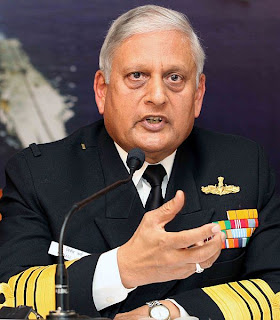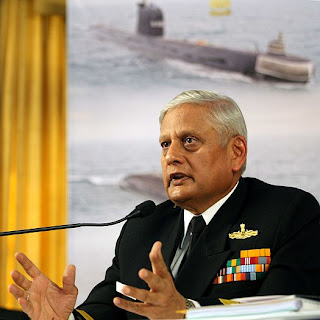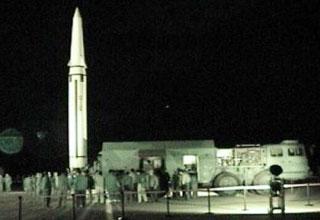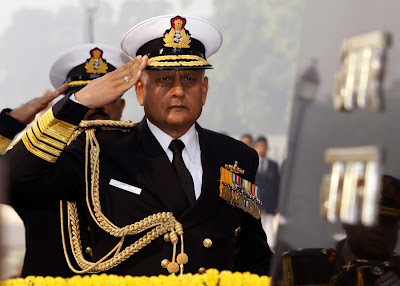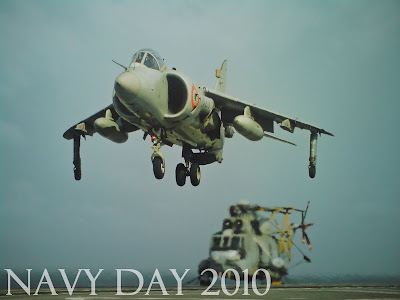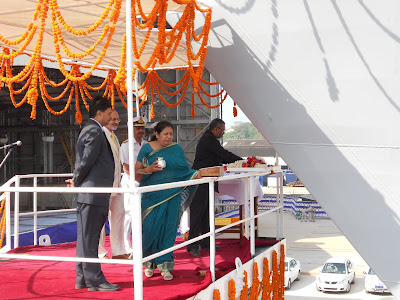Chief of Naval Staff Admiral Navy Day Press Conference
A combo of photos of India's Navy Chief Admiral Nirmal Verma at the annual Navy Day Press meet in Delhi. Navy Day is on December 4. Photos: Navy PRO
(Official Press Release from Indian Navy, reproduced below)
Good Morning Ladies and Gentlemen. At the outset, let me thank you for being here for this year's press conference. I can see that all forms and sections of the media are represented. I would like to take this opportunity to compliment you for your contributions in keeping the nation informed of our defence needs and imperatives.
I will make some opening remarks after which I will take your questions. As you are aware, on 4th Dec every year, we celebrate Navy Day, to commemorate the daring and innovative actions taken by our Navy during the 1971 conflict that helped contribute to our resounding victory. The Navy Day is an occasion to remember our war heroes and rededicate ourselves to the service of the nation. Indeed, the theme of this Navy Week, 'Glorious Wake, Vibrant Future', reflects this very sentiment.
Overview
I am happy to inform you that since I spoke to you at last year's Navy Week Conference, the Navy has pressed forward towards enhancing maritime security and safeguarding our economic and strategic interests. Today, the Indian Navy stands committed to providing stability not just in the Indian Ocean Region, but also ensuring unhindered access across the oceans, wherever our interests may lie.
Over the past year, we have maintained a high tempo of operations. Our ships, submarines and aircraft have conducted sustained operations towards safeguarding our maritime interests. We have operated in tandem with navies of friendly nations in the form of naval exercises, as well as cooperative security initiatives in support of our foreign policy. We have consolidated our coastal security organisation and infrastructure. In addition, we have moved steadily forward in our quest for greater indigenisation of our equipment along with nurturing of our human resources.
Capability Building
Generation of a modern force structure capable of undertaking maritime missions across the entire spectrum of operations has been our focus area.
There are, presently, 36 ships and submarines on order in various Indian shipyards. Our ship and submarine building programmes are largely on-track. Amongst the major projects, the construction of our Indigenous Aircraft Carrier at Kochi is progressing satisfactorily, though with some hiccups, and the refurbishment of Vikramaditya at Russia is doing well.
In terms of force development, our first stealth frigate, INS Shivalik, is already in commission, and two more ships of the class will be commissioned soon. Other significant programmes in the pipeline are three Kolkata Class destroyers, four advanced anti-submarine corvettes and six Scorpene Class submarines. Four modern Offshore Patrol Vessels and our second sail training ship are at various stages of construction. Orders for five Offshore Patrol Vessels and two Cadets' Training Ships have also been placed on private shipyards. The Government has also accorded approval to induct 4 Landing Platform Dock ships or LPDs under 'Buy and Make Indian' clause and six submarines under Project 75 India. Among the inductions planned from abroad are the Carrier Vikramaditya, which all of you know about, three follow-on ships of the Talwar Class from Russia, and two replenishment tankers from Italy. The first of the tankers is likely to arrive in India by the end of December this year and will be delivered to us by early 2011.
The Indian Navy is focussed on achieving self-reliance through indigenisation. Towards this end, we are committed to supporting our indigenous shipbuilding industry. The response from both public and private shipyards for the Navy's requirements has been encouraging, owing to which our force levels will see an upward trend. New ships will continue to be inducted at regular intervals.
I have mentioned Vikramaditya earlier. Her induction has been delayed due to increase in the scope-of-work, which consequently led to an unavoidable upward revision in price. I wish to inform you that since our last interaction, significant progress has been made, especially over the past few months. All efforts are being made to ensure that Vikramaditya is delivered to us by Dec 2012. We are fully seized of the significance of the project and both sides are doing their best to affect timely delivery of the ship.
In the interim, Mid-life Upgrades (MLUs) of 13 ships has been approved and the ships are being upgraded accordingly. After their MLU, the already very capable ships of the Rajput Class, as also those of the Godavari Class, will emerge as significantly more capable and modernised 21st Century combatants.
In order to enhance our surveillance capabilities,
twelve P 8I Poseidon Maritime Patrol Aircraft are planned for induction. During my recent visit to the US, I had the opportunity to personally review the progress of this project and I am happy to state that the production of the aircraft is well on track. These are extremely modern and capable aircraft and will enhance our surveillance, anti-surface and anti-submarine preparedness significantly. Delivery of these aircraft is expected to commence in Jan 2013. We have also initiated the process to acquire Medium Range Maritime Reconnaissance aircraft to further augment our surveillance capabilities.
The Navy's Carrier borne fighter aviation has also seen added impetus with the induction of the first batch of the MiG 29K aircraft in February this year. Our aircrews are already flying the aircraft and an Intensive Flying Training Unit has been set up to complete the task in a time-bound manner. An additional contract for 29 MiG 29K fighters has also been signed recently. Our indigenous naval fighter programme marked a significant milestone this year, with the
first 'roll out' of the naval version of the LCA on 6th July at Bangalore. We expect the first flight to take place his month.
The Navy is also in the process of procuring 16 Multi Role Helicopters to augment the surveillance and attack capabilities of ships. Procurement of the Naval Utility Helicopter, as a replacement for our Chetak fleet, has also been initiated. The existing fleet of Seaking and Kamov helicopters is planned for a Mid Life Upgrade in order to provide them a sophisticated sensor suite. All these steps would provide the requisite fillip for the Naval Air Arm to be even more effective in its assigned tasks.
We also have an indigenously developed data link and combat management system. It is a matter of great pride for us that a large percentage of the systems being inducted on ships are indigenous. It is even more heartening that some of these have a fair amount of in-house R&D contribution by naval personnel.
Infrastructure
Our expanding maritime interests require a growing Navy. To cater for such growth plans, we also have had to put new infrastructure in place. These include a second phase of expansion of the naval base at Karwar, planned induction of a second floating dock and upgradation of our dockyards and aircraft repair yards, to keep pace with new inductions and ensure infusion of new technologies.
Coastal Security Initiatives
Coastal security is a key area in our overall maritime security architecture. In this regard, one of the most significant achievements of the last year has been the integration of all maritime stakeholders, including the several State and Central agencies into the coastal security matrix. As a result, there is today far better coordination, synergy and understanding among all agencies. Intelligence and information sharing has undergone a transformational change. Real time information flow among all stakeholders has resulted in more effective and rapid response by the seagoing agencies to a developing situation.
The Indian Navy had established four Joint Operation Centres at Mumbai, Visakhapatnam, Kochi and Port Blair. In addition, the state Marine Police and other agencies such as Customs, Intelligence Bureau, Ports, etc. are also networked with these centres. Besides these, each coastal district is under an Area Operations Centre for coordinating coastal security activities.
In addition, coastal security exercises have been conducted in every coastal state in conjunction with the Coast Guard, marine police, customs, immigration and Port authorities to achieve and maintain a high level of synergy. In all, ten exercises on the West coast, nine on the East coast, two in L&M islands and two in A&N Islands have been conducted this year. During these exercises, several contingency scenarios were simulated and all agencies with a stake in coastal security participated, with a view to improve coordination, achieve integration and improve the coastal security mechanism even further.
In a focused drive to increase the awareness of our large fishing community and integrate it into the coastal security matrix, 89 awareness campaigns have been conducted, covering all coastal districts. This is an ongoing endeavour, and will be continued in the years ahead.
Maritime Domain Awareness
Improving our awareness of the maritime domain is key to maritime security. I am of the view that attaining awareness of the maritime domain is not a localized action to be undertaken by a single agency, but one that requires participation of many agencies at the national level including the Navy and Coast Guard, government departments concerned with maritime activities, governments of coastal states and island territories, law enforcement and intelligence agencies, and other stakeholders in maritime security.
Towards creating a common information grid to synergise the efforts of all stakeholders, an Approach Paper for achieving comprehensive Maritime Domain Awareness, was formulated by the Navy in March this year. The concept of National MDA was approved by the National Committee for Strengthening Maritime and Coastal Security (NCSMCS) in Apr 10 and subsequently, the Navy has formulated a Detailed Project Report for implementing it as a national project. Once implemented, integrated National MDA will enable effective sharing of maritime related information among all stakeholders, thereby leading to more informed decision making and faster response by security agencies. You would recall that I had mentioned during my interaction with you last year that this would have high priority in the Navy's agenda for this year. I am happy to report that we have maintained our timeline in this complex, but extremely important endeavour.
Blue Water Operations
While I have spoken at length about the progress made in enhancing our coastal security, I wish to emphasise that we have not neglected our blue water operations, and the Indian Navy continues to sharpen its capabilities through regular fleet exercises, both within the Navy, as well as with our major international partners. Suffice it to say, that our powder is dry and we stand ready to combat any malafide activity intended to harm our national integrity and interests.
Cooperative Maritime Security
As India's development is predicated on a stable geo-strategic environment, it is in our interest that we play an active role in this regard, based on the twin principles of cooperative security and shared prosperity. The Indian Navy has developed excellent professional relations through maritime interactions with regional as well as extra-regional powers. There is almost universal acceptance of the Indian Navy's credentials and recognition of the vital contribution that we can make towards the security and prosperity of the entire region. Drawing on our human resources and technical expertise, the Indian Navy is involved in both capacity and capability building of our maritime friends in the region. We are also the hub for hydrographic training in the IOR.
We are proud of the fact that the Indian Navy has emerged as a versatile and flexible diplomatic instrument for the country. Our initiatives have included MILANs at Port Blair which is attended not only by the South and SE Asian navies, but from even farther afield. We also have the distinction of undertaking naval exercises with all the major navies of the world, with 13 such exercises being held in 2010.
The Indian Ocean Naval Symposium (IONS), launched by Indian Navy, has provided a forward-looking framework for constructive engagement amongst navies of the region. This initiative has tremendous potential as an inclusive forum for all stakeholders that have legitimate interests in the region. The IONS has a membership of almost three dozen regional navies. In May this year, the Chairmanship of this grouping was passed on by me to the Commander of the UAE Navy for the period from 2010 to 2012. In the years ahead, I am sure IONS will continue to look at collective and cooperative solutions for issues in Indian Ocean. In addition, under the ASEAN Regional Forum (ARF), the Indian Navy has contributed positively to discussions on maritime security. We have also contributed to regional efforts for safe navigation in the Malacca Strait.
India today is seen as a net security provider. I am certain that you would agree that good order at sea is critical to our national interests. No navy can hope to ensure good order at sea on its own, and therefore cooperative efforts are increasingly becoming the norm. A robust Indian naval presence is in our interest, so that we can make effective contributions to a cooperative regional security order, in our areas of interest.
The cooperative approach of naval forces to fight piracy off the coast of Somalia is a case in point. Your Navy has discharged its responsibilities with distinction and we continue to have a ship on patrol in the Gulf of Aden escorting merchant ships in direct coordination with the Director General Shipping. To date, over 1350 merchant ships of varying nationalities have been escorted safely and about a hundred of these have been Indian flagged vessels. At least 22 piracy attempts have been averted by the Indian Navy's ships patrolling the Gulf of Aden. India is engaged with other countries on capacity building and consultations in the area of anti-piracy for keeping access points open and avoid choking of international trade.
Human Resource Development
I am of the opinion that our men and women are our most valuable assets. The Navy is facing a shortfall in both uniformed and civilian personnel. Civilian personnel form the backbone of our maintenance force and have longstanding expertise, which we can ill afford to lose. We are making all efforts in conducting special recruitment drives to make good the shortfalls. Shortages of service personnel are also being progressively reduced through additional recruitment.
A word about our women-officers. At the present juncture, women-officers are being inducted as SSC officers into the Law, Logistics, Observers and ATC Cadres of the Executive Branch, in the Naval Constructor Cadre of the Engineering Branch, and, in the Education Branch. The government has approved grant of permanent commission prospectively to women officers in Education, Law and Naval Constructor Cadres.
The well-being of our men and women is an important concern for the Government as well as the Navy. The Married Accommodation Project aimed at providing housing to maximum number of service personnel is progressing well. Our endeavour has been to initiate measures that contribute to an overall sense of well being, satisfaction and pride of our naval personnel and their dependents. Towards this end, the Government has approved upgradation of posts for sailors from the rank of Leading to Petty Officer, which would facilitate promotion of all Leadings to the rank of Petty Officer in a phased manner, within the initial engagement period of 15 years, as against periods of upto 19 years that they may need to wait for at present. Rehabilitation of naval widows has also been a focus area, along with generation of employment-related skills in spouses of naval personnel. We are also actively helping in the placement and employment of retired naval personnel in public sector units. These veterans comprise a large pool of talented and disciplined manpower and can contribute substantially to nation-building activities after they retire from active service.
Sports and Adventure
I am proud to state that 2010 has been a stellar year for achievement in sports and adventure activities. Commander Dilip Donde became the first Indian to complete a solo-circumnavigation of the globe under sail onboard the indigenous Indian Naval Sailing Vessel Mhadei when he arrived back in Mumbai on 22 May 10. He covered 21,600 nautical miles during his 276 day voyage. In continuation of this exploit, INSV Mhadei, with a crew of three officers and one sailor is presently participating in the Cape Town to Rio de Janeiro race.
Indian Navy's sportsmen have consistently done the country proud in the international arena. 81 naval sportsmen represented the country at various international sporting events during 2009-10, winning 19 Golds, eight Silvers and one Bronze medal in them. Naval sportsmen won six Golds, one Silver and one Bronze medal during the Commonwealth Games at New Delhi. A naval sailor, Sanjeev Rajput, MCPO II QA 3, was conferred with the Arjuna Award for excellence in Shooting. Naval sportsmen have also won three medals (two Silvers and one Bronze) at the Guangzhou Asian Games. It goes without saying, that we are extremely proud of their achievement.
Concluding Remarks
Let me conclude by stating that the future holds out numerous challenges for the Indian Navy as we step into the next decade. Along with force modernisation and operational capability enhancement, my focus would be towards maintaining a high tempo of operations towards strengthening all aspects of maritime security, as well as building a versatile, networked and capable maritime force that is suited to defend national interests in the future.
http://tarmak007.blogspot.com/2010/12/snapshots-snippets-from-navy-day-press.html

